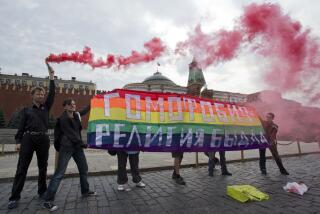ECONOMICS : Russia’s New Capitalism: a Guidebook
- Share via
MOSCOW — Transforming Russia into a nation of property holders--such is the ambitious goal of the government program launched two days ago from Murmansk to Magadan. What’s going on, and what’s at stake? Here are answers to common questions:
Question: What is a voucher?
Answer: It is a piece of paper that gives the bearer the right to purchase a chunk of the Russian economy. It is colored blue and beige and bears an image of the Russian “White House,” or government headquarters.
Q: What is the voucher’s value?
A: Its face value is 10,000 rubles, or $32.36 at the current Central Bank exchange rate.
Q: But how much is it really worth?
A: Only the privatization process itself, and supply and demand, will tell. Up to 7,200 enterprises are supposed to be sold off to private investors--an estimated 9% to 10% of Russian state property--and only vouchers will be accepted in exchange for some of their stock. In 1990, the assets of enterprises that are being mandatorily privatized were valued at 1.5 trillion rubles. Evenly divided among Russia’s 150 million people, that makes 10,000 rubles of assets per citizen, hence the voucher’s nominal value.
Q: Who is entitled to a voucher?
A: All Russian citizens who were living in Russia as of midnight, Sept. 1, have the right to what in Russian is called a “privatization check.” From President Boris N. Yeltsin to a prison inmate, each Russian is to get just one.
Q: What can a Russian do with the voucher?
A: Three things. First, he can buy shares of a state-run enterprise that are to be sold at auctions organized by the Federal Property Fund. Second, he can place it in a private mutual fund, which itself will buy shares of privatized companies and spread the risk and profits among a pool of investors. Third, he can sell the voucher to a speculator, trade it--or simply give it away.
Q: Are all kinds of enterprises being privatized?
A: No. Nuclear power plants, defense industries, television and radio broadcasting centers, oil and gas wells, roads, mineral deposits and tracts of land are among those economic resources being kept in government hands. There is also a separate privatization process for municipal holdings such as bookshops or restaurants. In theory, all other state-run enterprises with 1,000 employees or more will be privatized. Smaller firms may also ask to “go private,” hence the current confusion about how many will actually be sold into private hands.
Q: Does the voucher arrangement mean that ordinary citizens will take control of Russia’s biggest enterprises?
A: Not really. Each factory or firm can choose one of three formulas for becoming a joint-stock company. But under any of those formulas, vouchers can be used only to buy 35% of the company’s stock. One scheme that seems destined to become popular encourages workers to assume ownership of their place of employment and offers employees stock for free or at a 30% discount.
Q: Are there any risks?
A: Yes. Many Russian enterprises are nearly bankrupt, and vouchers spent on them will be money thrown out the window. The average Russian will also be hard pressed to attend many auctions or secure reliable information about enterprises being sold off from one end of the country to the other. For the typical investor, government officials believe the safest bet will be to spend the voucher to buy a share in a mutual fund.
Q: Is the “voucherization” program a success?
A: Russians have until Dec. 31 to obtain their voucher, but judging by the initial reaction, many are in no rush to become investment capitalists. On the first day of distribution, only 120,000 Muscovites lined up to get their vouchers, one local radio station said.
Dahlburg is a Times staff writer and Loiko is a researcher in The Times’ Moscow Bureau.
More to Read
Sign up for Essential California
The most important California stories and recommendations in your inbox every morning.
You may occasionally receive promotional content from the Los Angeles Times.













